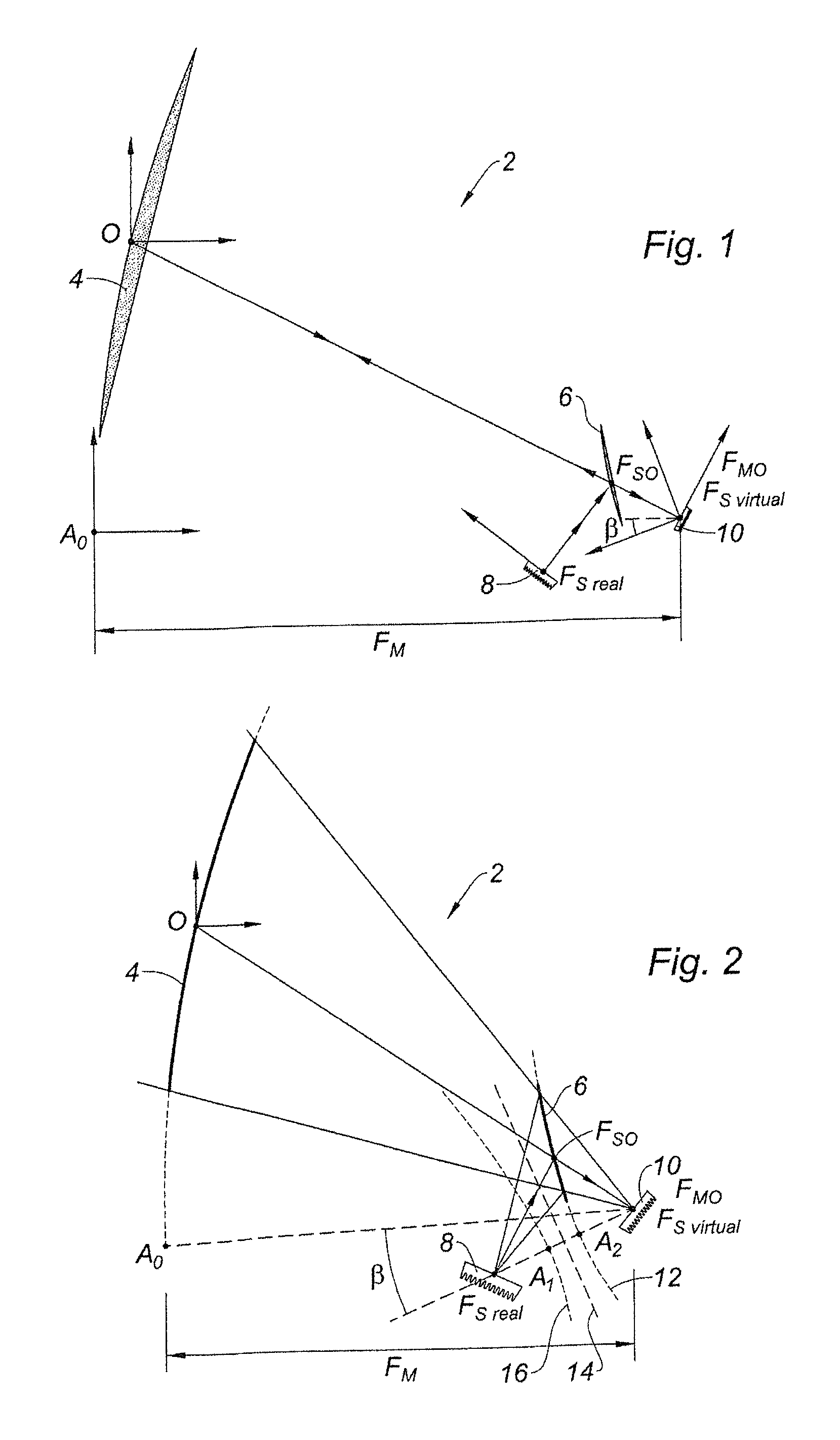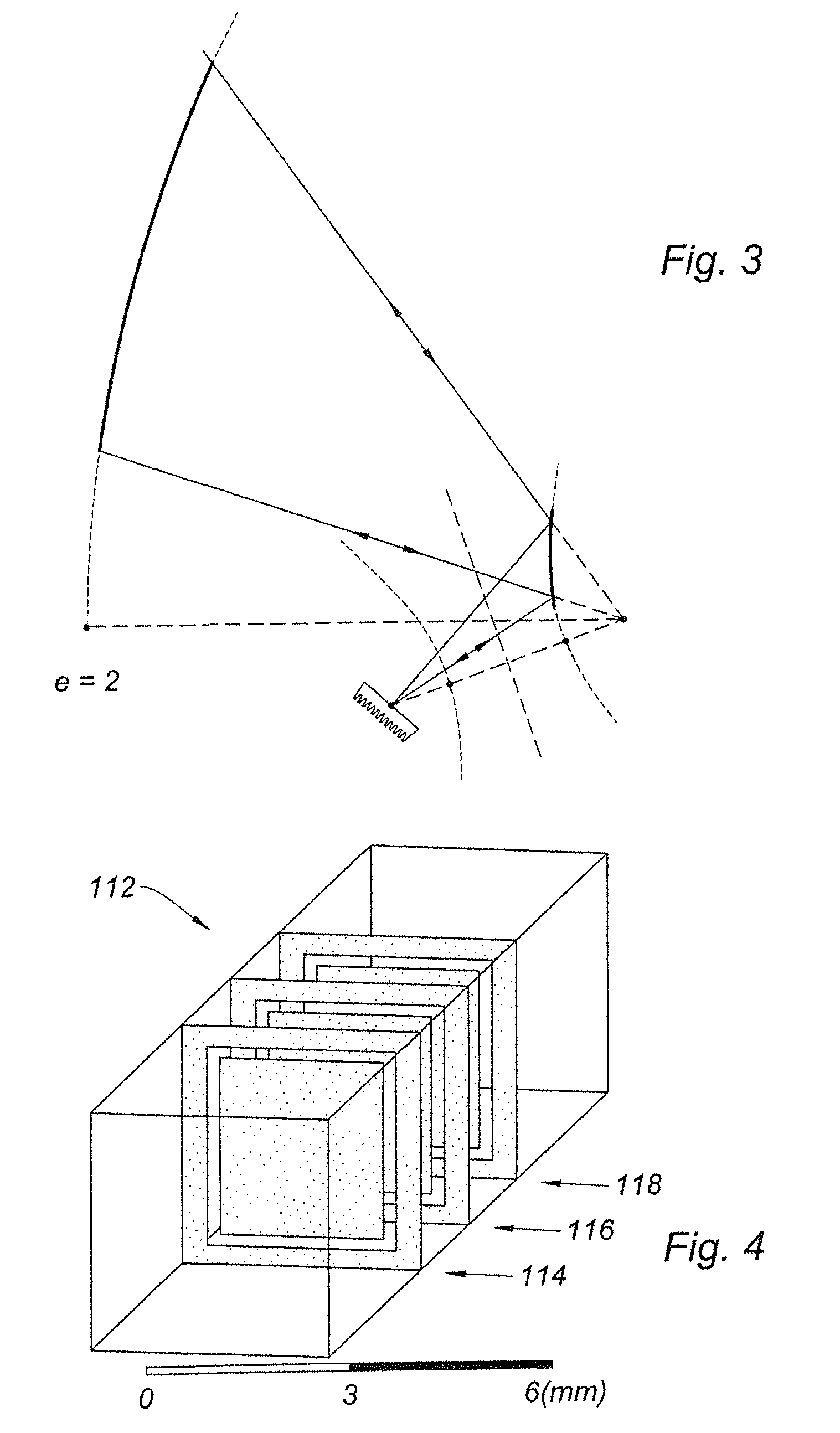Dual-band multiple beam reflector antenna for broadband satellites
a technology of multiple beams and reflectors, applied in the direction of antennas, simultaneous aerial operations, electrical equipment, etc., can solve the problems of poor cross-over level between the beams generated by adjacent feeds (10 db), very limited space for other missions, and configuration restrictions. , to achieve the effect of high rf performan
- Summary
- Abstract
- Description
- Claims
- Application Information
AI Technical Summary
Benefits of technology
Problems solved by technology
Method used
Image
Examples
first embodiment
[0052]According to FIGS. 1-2 and the invention, a broadband communication satellite antenna 2, for producing a dual-band multiple beam coverage, made of a transmit multiple beam coverage operating in a first transmitting frequency band BTx and of a receive multiple beam coverage operating in a second receiving frequency band BR, is based on an offset dual-optics configuration.
[0053]The first transmitting frequency band BTx and the second receiving frequency band BRx are separate or in other terms do not overlap. These bands are two separate sub-bands of a same third band, here the Ka-band.
[0054]Generally in communication satellite applications, the third band is comprised within the family of L-band, S-band, C-band, X-band, Ku-band, Ka-band and Q / V-band.
[0055]The broadband communication satellite antenna 2 comprises a single main parabolic reflector 4, a hyperbolic sub-reflector 6, a first transmitting Multiple-Feed-per-Beam (MFB) feed system 8 configured to generate the first trans...
second embodiment
[0106]According to the FIGS. 10 and 11, and the invention, a broadband communication satellite antenna 202, for producing a dual-band multiple beam coverage, made of a transmit multiple beam coverage operating in a first transmitting frequency band BTx and of a receive multiple beam coverage operating in a second receiving frequency band BRx, is based on an offset dual-optics configuration.
[0107]Like the antenna 2 of FIGS. 1 and 2, the first transmitting frequency band BTx and the second receiving frequency band BRx are separate or in other terms do not overlap. These bands are two separate sub-bands of a same third band, here the Ka-band. As a variant, the third band may be also L-band, S-band, C-band, X-band, Ku-band or Q / V band.
[0108]The broadband communication satellite antenna 202 comprises a single main parabolic reflector 204, a hyperbolic sub-reflector 206, a first transmitting Multiple-Feed-per-Beam (MFB) feed system 208 configured to generate the first transmit coverage an...
third embodiment
[0124]According to the FIG. 12 and the invention, a broadband communication satellite antenna 302, for producing a dual-band multiple beam coverage, made of a transmit multiple beam coverage operating in a first transmitting frequency band BTx and of a receive multiple beam coverage operating in a second receiving frequency band BRx, is based on an offset dual-optics configuration.
[0125]Like the antennas 2 and 202, the first transmitting frequency band BTx and the second receiving frequency band BRx are separate or in other terms do not overlap. These bands are two separate sub-bands of a same third band, here the Ka-band. As a variant, the third band may be also L-band, S-band, C-band, X-band, Ku-band or Q / V-band.
[0126]The broadband communication satellite antenna 302 comprises a single main parabolic reflector 304, a flat sub-reflector 306, a first transmitting Multiple-Feed-per-Beam (MFB) feed system 308 configured to generate the first transmitting coverage and to illuminate the...
PUM
 Login to View More
Login to View More Abstract
Description
Claims
Application Information
 Login to View More
Login to View More - R&D
- Intellectual Property
- Life Sciences
- Materials
- Tech Scout
- Unparalleled Data Quality
- Higher Quality Content
- 60% Fewer Hallucinations
Browse by: Latest US Patents, China's latest patents, Technical Efficacy Thesaurus, Application Domain, Technology Topic, Popular Technical Reports.
© 2025 PatSnap. All rights reserved.Legal|Privacy policy|Modern Slavery Act Transparency Statement|Sitemap|About US| Contact US: help@patsnap.com



